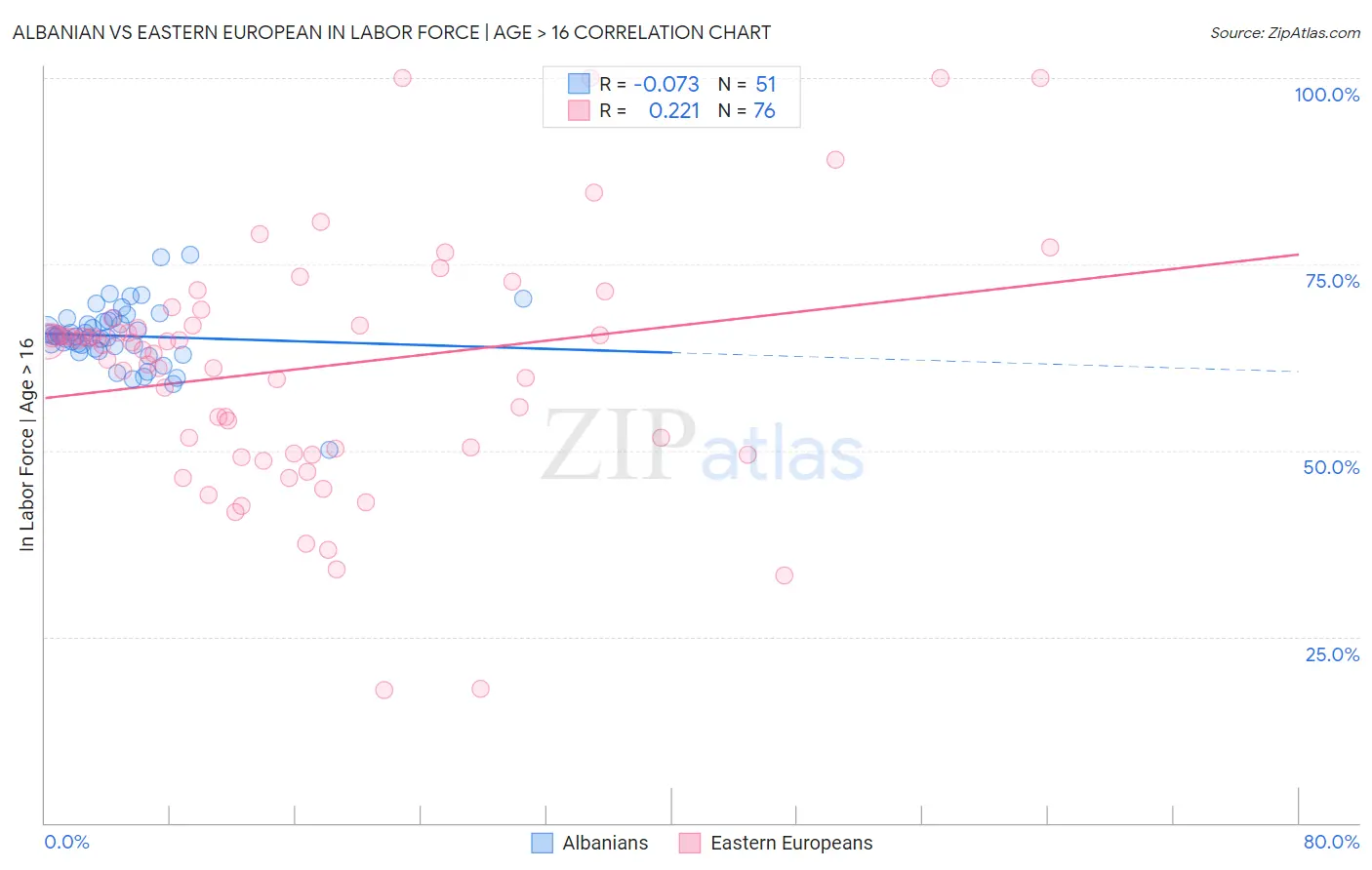Albanian vs Eastern European In Labor Force | Age > 16
COMPARE
Albanian
Eastern European
In Labor Force | Age > 16
In Labor Force | Age > 16 Comparison
Albanians
Eastern Europeans
65.3%
IN LABOR FORCE | AGE > 16
70.8/ 100
METRIC RATING
162nd/ 347
METRIC RANK
65.1%
IN LABOR FORCE | AGE > 16
46.2/ 100
METRIC RATING
177th/ 347
METRIC RANK
Albanian vs Eastern European In Labor Force | Age > 16 Correlation Chart
The statistical analysis conducted on geographies consisting of 193,265,279 people shows a slight negative correlation between the proportion of Albanians and labor force participation rate among population ages 16 and over in the United States with a correlation coefficient (R) of -0.073 and weighted average of 65.3%. Similarly, the statistical analysis conducted on geographies consisting of 461,261,446 people shows a weak positive correlation between the proportion of Eastern Europeans and labor force participation rate among population ages 16 and over in the United States with a correlation coefficient (R) of 0.221 and weighted average of 65.1%, a difference of 0.29%.

In Labor Force | Age > 16 Correlation Summary
| Measurement | Albanian | Eastern European |
| Minimum | 50.1% | 17.9% |
| Maximum | 76.2% | 100.0% |
| Range | 26.1% | 82.1% |
| Mean | 65.4% | 61.1% |
| Median | 65.3% | 64.3% |
| Interquartile 25% (IQ1) | 63.7% | 49.9% |
| Interquartile 75% (IQ3) | 67.4% | 66.8% |
| Interquartile Range (IQR) | 3.7% | 16.9% |
| Standard Deviation (Sample) | 4.2% | 16.2% |
| Standard Deviation (Population) | 4.2% | 16.1% |
Demographics Similar to Albanians and Eastern Europeans by In Labor Force | Age > 16
In terms of in labor force | age > 16, the demographic groups most similar to Albanians are Australian (65.3%, a difference of 0.010%), South African (65.3%, a difference of 0.010%), Danish (65.3%, a difference of 0.030%), Immigrants from South Africa (65.3%, a difference of 0.040%), and Immigrants from Kazakhstan (65.3%, a difference of 0.040%). Similarly, the demographic groups most similar to Eastern Europeans are Swedish (65.1%, a difference of 0.010%), Trinidadian and Tobagonian (65.1%, a difference of 0.010%), Immigrants from Haiti (65.1%, a difference of 0.030%), Macedonian (65.1%, a difference of 0.040%), and Nicaraguan (65.1%, a difference of 0.040%).
| Demographics | Rating | Rank | In Labor Force | Age > 16 |
| Immigrants | Syria | 74.6 /100 | #159 | Good 65.3% |
| Immigrants | South Africa | 73.5 /100 | #160 | Good 65.3% |
| Australians | 71.3 /100 | #161 | Good 65.3% |
| Albanians | 70.8 /100 | #162 | Good 65.3% |
| South Africans | 69.8 /100 | #163 | Good 65.3% |
| Danes | 68.8 /100 | #164 | Good 65.3% |
| Immigrants | Kazakhstan | 68.1 /100 | #165 | Good 65.3% |
| Immigrants | Western Asia | 67.3 /100 | #166 | Good 65.3% |
| Immigrants | Belarus | 66.0 /100 | #167 | Good 65.2% |
| Serbians | 63.5 /100 | #168 | Good 65.2% |
| Arabs | 62.4 /100 | #169 | Good 65.2% |
| Immigrants | Israel | 61.7 /100 | #170 | Good 65.2% |
| Israelis | 61.6 /100 | #171 | Good 65.2% |
| Immigrants | Sweden | 61.3 /100 | #172 | Good 65.2% |
| Immigrants | Ukraine | 53.7 /100 | #173 | Average 65.1% |
| Macedonians | 50.0 /100 | #174 | Average 65.1% |
| Nicaraguans | 49.7 /100 | #175 | Average 65.1% |
| Swedes | 47.4 /100 | #176 | Average 65.1% |
| Eastern Europeans | 46.2 /100 | #177 | Average 65.1% |
| Trinidadians and Tobagonians | 45.2 /100 | #178 | Average 65.1% |
| Immigrants | Haiti | 43.3 /100 | #179 | Average 65.1% |